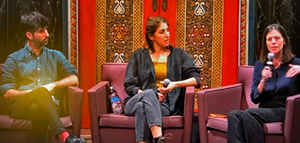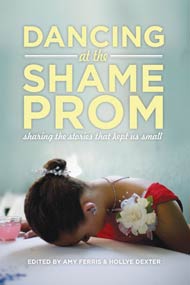Standing Together Leaders Abed and Green Lay Out a New Vision: “We’re In This Together”
From Left to Right: Alon-Lee Green, Sally Abed, Libby Lenkinski
Since the Hamas attack of October 7, it seems like streamed events examining the situation in Israel/Palestine have multiplied exponentially. The conversation has shifted, and Jewish friends and colleagues who previously thought the issue was tangential at best, are now starting to connect the dots in a way they never expected.
Wednesday was a usual day of multiple Zooms. I started with the positivity of a talk from The Parents Circle, where two members, one Palestinian and the other Jewish, spoke about their journeys of loss and desire for peace and reconciliation. The clarity of Laila Alshei and Ayeleet Harel underscored that women’s voices are too often missing at the highest echelons of decision-making on both sides of the equation.
The second event looked at The Israel-Hamas War:Where Is It Headed? sponsored by Partners for Progressive Israel. (Full Disclosure: I am on the planning committee for their 2023 Virtual Symposium.) The panel parsed the different potential eventualities after the “war concludes.”
Wednesday’s news shifted the puzzle pieces with Israel’s announcement of daily 4-hour “pauses” for humanitarian concerns. I had been feeling anxious all day. The steady barrage of overwhelming videos, photographs, and social media posts was unnerving. The politics of Israel/Palestine have spilled over into American and hyperlocal New York politics—as Jews square off against one another. It had been happening in the past few election cycles, with candidates weaponizing antisemitism. Now, it was at a fevered pitch. It was non-stop daily acrimony. Posters were put up; posters were pulled down. Even a trip to the supermarket could be fraught, depending on who I ran into. I settled in for the final meeting of the day. I had hoped to attend in person, but the beginnings of a sore throat had convinced me otherwise.
Sally Abed and Alon-Lee Green of the organization Standing Together had traveled to America to do a talking tour on the East Coast about their vision for a new reality in Israel. B’nai Jeshurun, a synagogue on the Upper West Side of Manhattan, had snagged them for an evening.
It wasn’t the first time I had heard them. I knew they were young and charismatic, with a palpable chemistry between them. “Do you want to answer that?” Abed asked Green quietly, “Or should I?”
An Israeli-Jewish man and an Israeli-Palestinian woman were putting forth a new prototype in a lucid, concise voice. The message was clear. “The day after [the war ends], no one is going to leave or be eradicated.”
To a full house and over 400 streaming viewers, the takeaway was the “principle of universal humanity.” A resonant message for a Temple setting.
Libby Lenkinski of the New Israel Fund anchored the evening. Standing Together is one of their grantees. There was a brief intro of Abed, the Head of Development and an elected national leader of Standing Together, and Green, the National Co-Director. Then, a rundown on the organization’s genesis, founded in 2015 after another Israeli “operation” in Gaza. At the time, Netanyahu stated, “We will forever live on the sword.”
That’s the ethos that Standing Together is opposing. Green said, “We have to shift the paradigm. We have to move [away] from inequality and occupation. We have to build sustainable power for change for all marginalized groups.” (Green organized the first trade union of waiters in Israel.)
Abed spoke about the emotional, existential threat both Jewish and Palestinian Israelis felt while underscoring, “Our existence is dependent on the other.” She added, “We are grieving for both peoples.” However, for Palestinian Israelis, the fear and anguish are being “criminalized.” Whether it is in the sphere of employment, education, or social media, Palestinians don’t feel safe to exist. “Right now, they are trying to erase us,” Abed said.
Green dug into why they had felt it was essential to take the time to come to the United States to spread the message that “both peoples deserve life and security” and why they are working to engage those joint sectors of Israeli society. “We are trying to stand in solidarity while political forces are trying to use the shock and horror to move Jewish and Palestinian citizens of Israel apart.”
Next was a bird’s-eye view of Israeli politics and a discussion about the ramifications of the most right-wing government in Israel’s history. Green noted that Israeli television stations run a daily chyron tabulating the number of Palestinian civilians dead in Gaza. Simultaneously, Gaza being repopulated with settlements has been floated as an idea. Referencing the creation of “new fronts” and the uptick in violence in the West Bank, Green said, “They [the government] want to lead us into an internal war.”
With Jewish extremists trying to present Palestinian citizens of Israel as a fifth column, Standing Together is focusing on the de-escalation of those inflammatory messages, reframing the dialogue with their code words: “We’re in this together.”
The asymmetry of power between Jewish and Palestinian citizens of Israel and the physical threats towards the latter was acknowledged, as was the horrific events of October 7, the largest massacre of Jews in one day since the Holocaust.
Standing Together focuses on actions inside of Israel. To that end, they are working to secure bomb shelters for all those who lack protection. Every third day, they have organized Jewish and Palestinian solidarity events. (They identify their messaging with the color purple.) Green said, “That’s the start of the solution,” before riffing on the Eldridge Cleaver quote, “If you are part of the problem, you are not part of the solution.”
Green also dismissed the adage of “managing” the situation. He said, “There are 2.2 million Palestinians under siege. The conception you can maintain this—counting calories (A reference to food allowances and the Gaza blockade.). The government says, ‘This time is for real.’ How do we break out of the status quo? Both peoples call this their home. Others who contest this are delusional.”
Abed shared the difficulty of the space she holds in the struggle. Those in the Palestinian Diaspora may see her as “irrelevant.” She said, “I can isolate myself from Israeli society and talk only about liberation. The other option is to fight systemic racism and take responsibility—to make Israeli society a better place while claiming my identity as a Palestinian. We need popular demand from Israeli society. I need to be relevant.”
Their Theory of Change (2019) leads to what Green qualifies as trying to “build a new political entity.” It outlines how a new majority that emanates from “a broad coalition of diverse communities” can bring about a national transformation. Green said, “The people demand social justice. Changes happen because of social movements.” The philosophy underpins creating “a large social-political movement while incubating a new eco-system of leadership
Will this lead to a political run by either of them? That was left unanswered.
However, it was apparent that everyone was trying to pinpoint what would transpire “the day after” while acknowledging that the ongoing disaster could possibly “lead to a sea change.”
Green stated, “It’s an extremely dangerous moment. In the middle of a war, we are fighting about what kind of society we want to be. It’s very much obvious that you can’t separate a right-wing government from everything else. You can’t maintain the status quo. Ending the occupation is a key issue.” He emphasized, “It starts with the question of equality.”
The discussion shifted to the United States and how building a joint new left coalition was necessary. Abed hashed out the importance of understanding that a bridge must be made between the Israeli and American left. There was direction on this matter, including the suggestion that the American left was not “containing the complexity” of the lives of all Israelis—and were being dismissive by drilling down on what Green termed “an academic approach versus a reality on the ground approach.”
Audience members had submitted written questions on cards and were eager to know how they could help. One of the inquiries touched on American policy. Green emphasized, “What happens in the United States impacts Israel. Create an umbrella. Don’t give Israel an open check.”
The cycle of violence continues. The extent and methodology of Israel’s response will continue to be parsed on a military and a moral level. Perhaps the real question is why so many people find it hard to believe another approach could be possible.
Photo: Marcia G. Yerman




